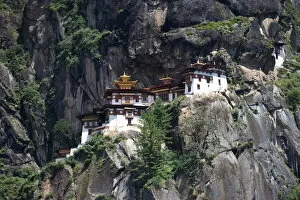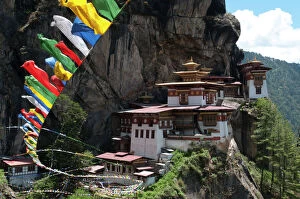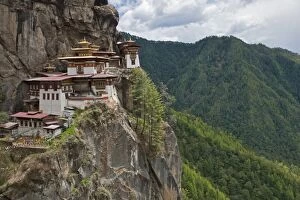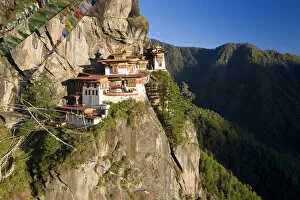Taktshang Goemba Collection
"Taktshang Goemba, also known as Tiger's Nest Monastery, is a breathtaking sight perched on the edge of a sheer cliff in the Paro Valley of Bhutan
For sale as Licensed Images
Choose your image, Select your licence and Download the media
"Taktshang Goemba, also known as Tiger's Nest Monastery, is a breathtaking sight perched on the edge of a sheer cliff in the Paro Valley of Bhutan. This iconic monastery, built in the 8th century, holds great significance for Buddhists and attracts visitors from all over the world. Legend has it that Guru Rinpoche flew to this sacred site on the back of a tigress, hence its name. The monastery seems to defy gravity as it stands 900 meters above the valley floor. Its stunning architecture and spiritual aura make it Bhutan's most famous landmark. As you approach Taktshang Goemba, colorful Buddhist prayer flags flutter in the wind, creating a mesmerizing spectacle against the backdrop of lush greenery and towering cliffs. These flags symbolize prayers being carried by the wind to bring peace and blessings to all beings. Visiting this monastery is not for faint-hearted adventurers; it requires hiking along steep trails with awe-inspiring views at every turn. But once you reach your destination, you'll be rewarded with an experience like no other – stepping into a place where spirituality meets natural beauty. Inside Taktshang Goemba, you'll find ornate temples adorned with intricate murals depicting Buddhist teachings and deities, and is a tranquil space where monks chant their prayers and devotees seek solace amidst serene surroundings. The journey to Tiger's Nest may test your physical endurance but will undoubtedly nourish your soul. As you stand at this remarkable vantage point overlooking Paro Valley, take a moment to reflect on life's wonders and feel connected to something greater than yourself. Taktshang Goemba Monastery is more than just an architectural marvel; it represents Bhutanese culture deeply rooted in Buddhism. It serves as a reminder that faith can move mountains – or perch monasteries on cliffs – if one believes strongly enough. "






